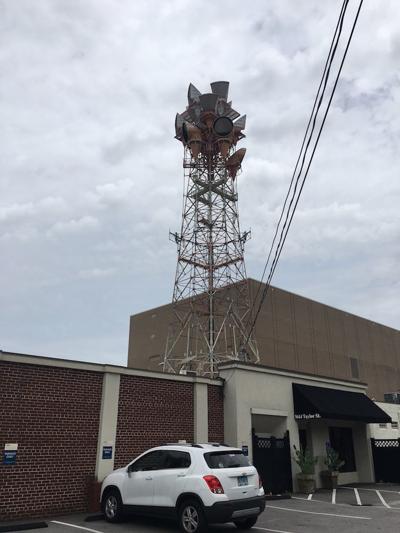
I’ve heard a lot of accounts over the years of this strange Taylor Street tower with the giant ice cream cone-shaped things stuck to it. Some say the cones are old air-raid sirens, or alarms to alert Columbians of a Lake Murray dam breach. I’d also heard the tower was owned by WIS for some sort of analog TV broadcasting.
None of those, it turns out, is true. I spent several weeks this summer tracking down the answer. The nearly 200-foot tower is owned by AT&T, and the cones are what’s called microwave cone antennas.
A network of these cone-festooned towers, built in the 1950s and ’60s, once crisscrossed the entire country. They were the first to use waves rather than physical wires strung from pole to pole.
According to one enthusiast, microwave antenna towers revolutionized telecommunications.
“In their heyday, the towers and their microwave paths formed a network that wove the United States together in a cohesive telecommunications web,” writes Daryl Gibson, who used to maintain a website devoted to AT&T’s Long Lines microwave network. “Before the towers were built, and automatic switching was put in, long distance calling was a great deal more difficult. After the network was installed, it became suddenly second nature, and a good deal less expensive.”
Some of those early microwave cone antenna towers were reportedly built to withstand nuclear blasts, an artifact of the Cold War era. And the cones themselves are heavy. When similar antennas were removed from a tower in Indiana a few years ago, the local paper wrote that each cone weighed 2,500 pounds.
The tower here in Columbia was built by Southern Bell — the regional subsidiary of AT&T back when it held a monopoly on the telecommunications industry — which had offices on Hampton Street, right in front of the tower.
The microwave antennas are no longer in use, according to AT&T’s corporate spokespeople, but they pose no danger. The tower itself is currently used to provide wireless service.
Oddly, it took some doing to figure out exactly when the tower was constructed.
Southern Bell bought the property in 1957; AT&T acquired it in 1984, likely as part of the court-mandated breakup of the Bell system. The FCC’s antenna registry lists the tower as having been built in 2002 — clearly inaccurate, but possibly the date the current wireless antennas on the tower became active. AT&T’s corporate folks simply told me the tower is “more than 30 years old.”
I called the maintenance contact person for the property, who told me he was “not supposed to talk about” the tower.
The State’s archives provided better clues. A 1959 article, “Tall Towers to Bring Better Phone Service,” described Southern Bell’s plans to build towers in Columbia and Sumter for a “brand new Microwave System, now in preparatory stages of development,” to be in service by April 1960. The tower would be built behind the company’s then-new Long Distance Center on Hampton Street. The total project, consisting of four towers (one in each city, and two in between), was to cost $360,000. At the time, there was only one other Southern Bell microwave line in place in South Carolina — linking Charleston and Augusta, Georgia.
But when did the tower actually go up? I squinted at aerial photos of the city dating back decades — images the University of South Carolina is good enough to make available online — to no avail. It took an actual visit to USC’s map library to find what I was looking for. There, in an aerial photo of downtown Columbia dated simply “1959,” I saw a familiar shadow. It stretched north-northwest across Taylor Street, casting its unmistakable silhouette on the grounds of the Robert Mills House across the street. You can see the same shadow in Google’s current satellite photo of the area. It’s not clear whether the tower was finished yet in that 1959 image, but it was certainly on its way.
Microwave cone antenna towers still dot the country. They’re becoming scarcer, though. Many have been removed; other stand weirdly unused in rural parts of the country.
But AT&T says they have no plans to demolish this particular tower. So for the foreseeable future, we’ll have a piece of telecommunications history right in the heart of Columbia.
Got burning questions? Let us know: editor@free-times.com.







